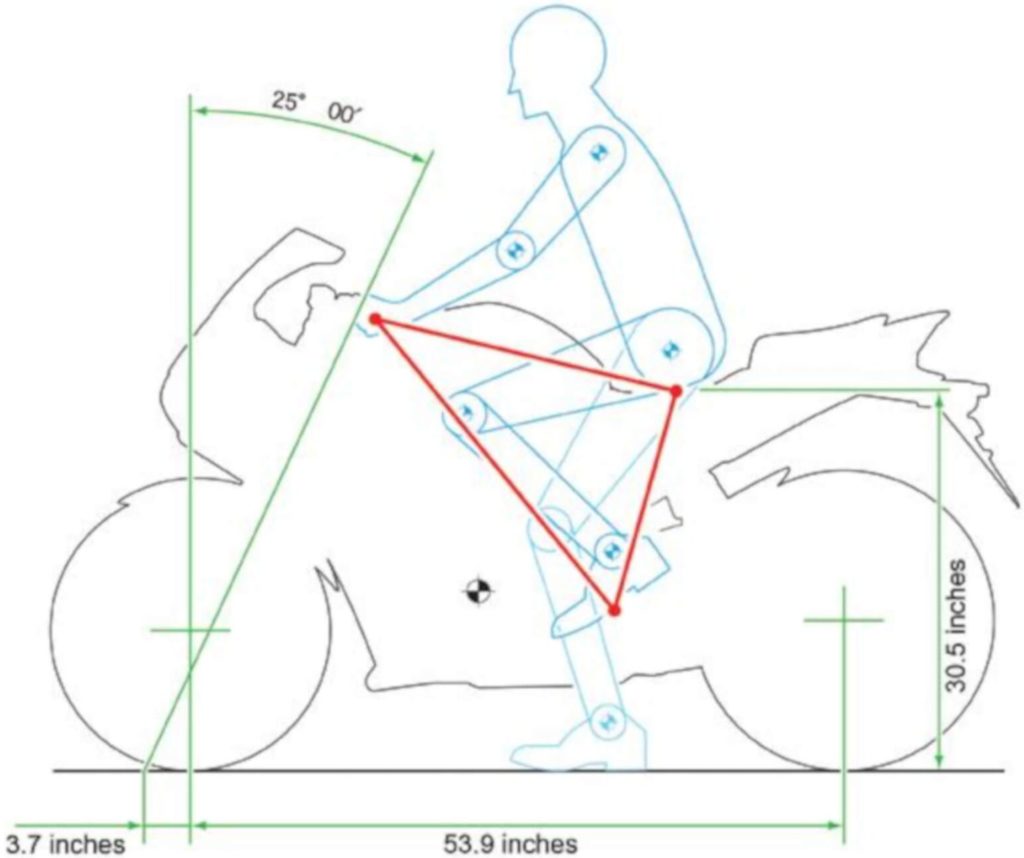To arm you with a bit more knowledge when comparing motorcycles, I want to at least give you a broad overview of major characteristics that really separate the different classes of motorcycle. I’ll have to make a few hand-wavy assumptions to keep it short, but this should at least give you enough information to know what to look for when comparing bikes.
The next article, Types of Motorcycles, will use this information to go a bit deeper into motorcycle classes than we cover in the Rider Handbook or the eCourse.
Motorcycle Geometry
Rake and Trail
Some of the most important characteristics of how a motorcycle handles are :
- Rake: the angle of the front forks. Steeper (closer to vertical) means faster steering, shallower (less vertical) means more stability.
- Trail: the distance between the contact patch and a straight line drawn through the forks to the ground. Less trail means faster steering, more trail means more stability.
- Wheel & tire size: Larger wheels (diameters >19″) can roll over bumps and have a lot of rolling momentum, making them ideal for dual sports and touring bikes. Smaller wheels (most often 17″) weigh less, can accelerate (and decelerate) quickly, so they are used more often on performance-oriented motorcycles.
The relationship between rake & trail is what gives motorcycles their self-correcting behavior and dictates just how much effort it takes to steer. While rake & trail are directly related (more rake implies more trail), manufacturers can also mount the wheel offset to the end of the forks, adjusting the trail.
There are other factors, like steering offset and the distance between the wheels (wheelbase), but rake, trail, and wheel size are probably the most import aspects of motorcycle handling & feel. All of these factors also tend to be related:
- Sportier bikes have steep rake angles, less trail, smaller wheels, and a shorter wheelbase
- Cruisers & choppers have shallow rake angles, lots of trail, large wheels, and long wheelbases
Those are the two extremes, and most categories of motorcycle will fall somewhere in between or mix and match as needed depending on their intended use.
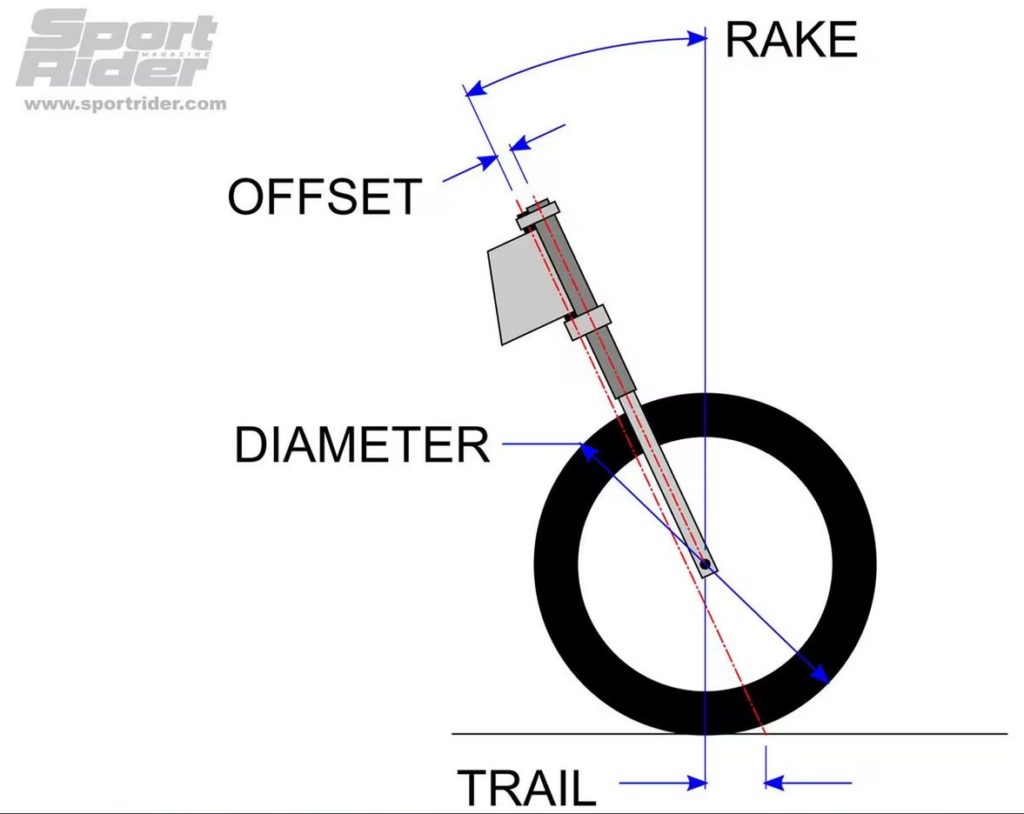
Steeper rake angles (the closer the forks are to vertical) give less trail, which makes the motorcycle more responsive to steering input. It can also lead to a feeling of instability at low speeds. Shallower or slacker rake angles come with more trail and a mellow ride, but require more input from the handlebars to make large steering corrections like swerving.
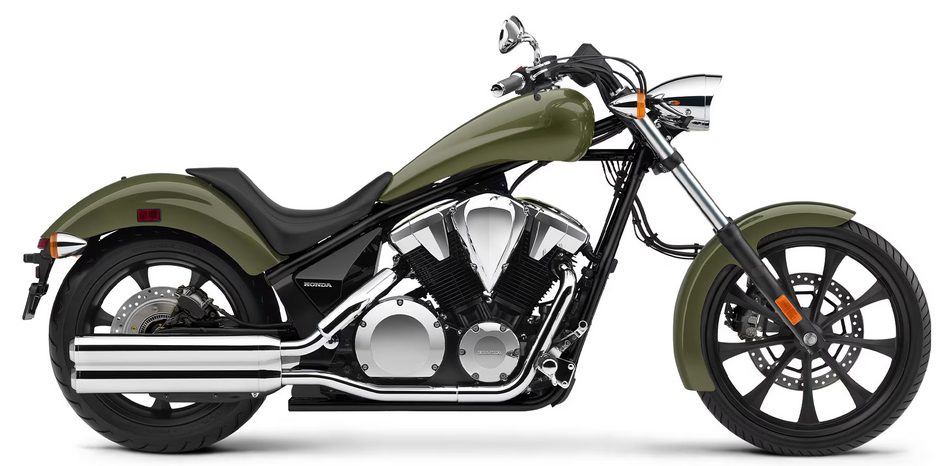
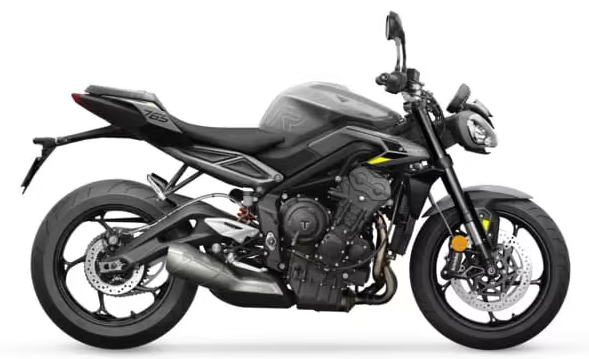
Compare the front ends of the Honda Fury, a chopper, to the Triumph Street Triple, a performance-oriented naked bike. The Fury will feel more stable in a straight line but the Street Triple will respond faster to steering input and has a much tighter turning radius.
The Rider Triangle
Your body position on a motorcycle has a huge impact not just on comfort, but also on how easy it is to control the motorcycle. The “rider triangle” is the triangle that’s formed by your butt, feet, and hands when in a riding position.
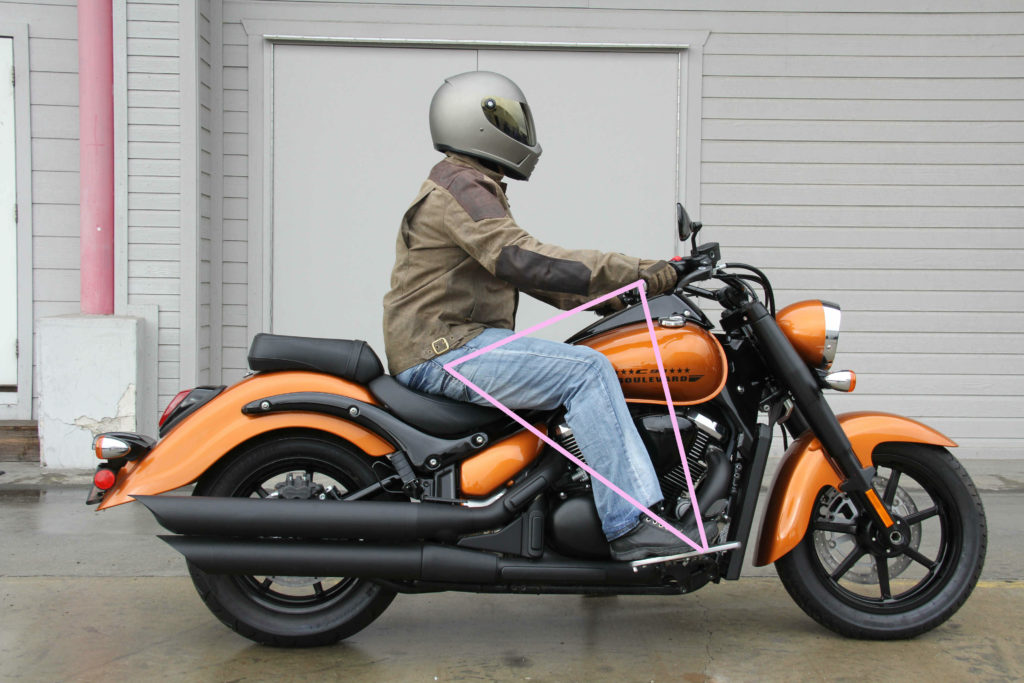
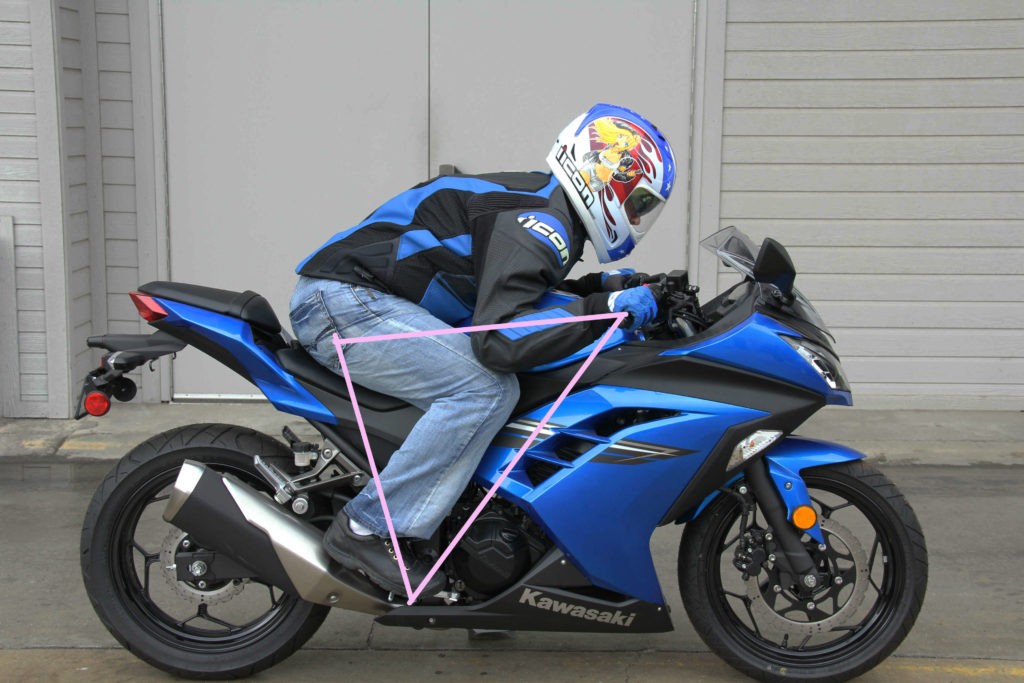
A feet-forward position (like on a cruiser) may be comfortable for short rides, but it limits your ability to shift position and makes it harder to use body positioning to help with steering and balance. A sportier leaned-forward position is aerodynamic and gives you the most ability to shift your weight to either side when cornering, but can put strain on your back, neck, and wrists for longer rides.
A neutral position is somewhere in between these extremes. Your feet are directly under your knees and your hands are about level with your elbows. This gives you the most freedom of movement and puts the least strain on your body. Compare the riding position of the cruiser and sport bike to a more neutral position:
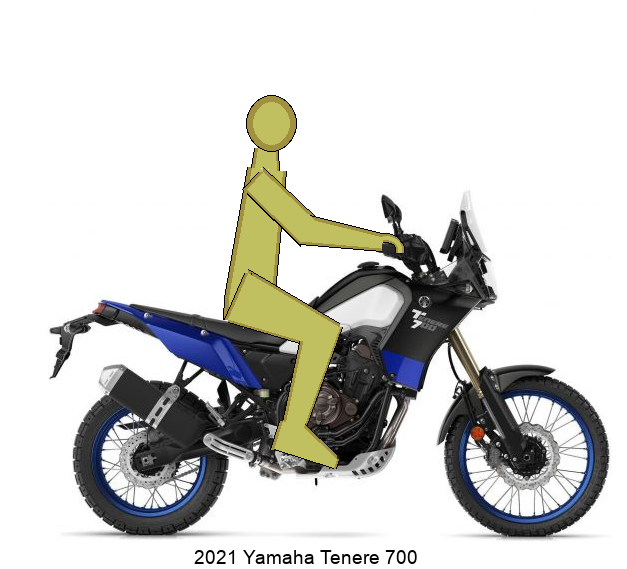
Motorcycle Engines
Another important aspect to consider when choosing a motorcycle is the type and size of its engine. When someone describes a bike as small or large, they generally are referring to the displacement of the engine in addition to the bike’s physical dimensions. Displacement, measured in cubic centimeters (cc) or cubic inches (ci.), measures the total volume of the combustion chamber(s) in an engine.
While it’s true that smaller engines are going to be less powerful than larger engines of the same type, different engine types have vastly different performance characteristics. A 500cc engine would be on the upper end of power for a dual sport, mid-range for a sport bike, and on the low end for a cruiser.
Another important characteristic of engines are the number of cylinders & pistons they have, which is between one and four for most common street bikes (large touring bikes like the Honda Gold Wing or BMW K1600 have six, but it’s relatively rare and usually quite expensive).
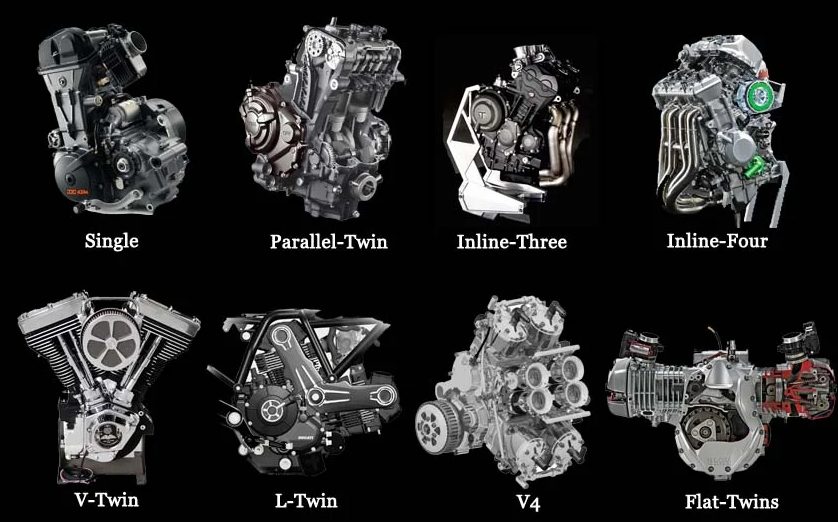
Engine power is often described in torque and horsepower. Torque is the amount of force that the engine applies to the wheel with each revolution, while horsepower is torque measured over time. Generally, torque describes and engine’s ability to accelerate at lower RPMs, while horsepower describes the engine’s ability to achieve high speeds at high RPMs. Engines tend to shift from being torque-focused to horsepower-focused as you add cylinders, but large engines can have plenty of both.
- Single Cylinders (singles): Simple & lightweight, but with high power-to-weight ratios. Often used in dual sports and some entry-level bikes where limiting weight is important.
- Two Cylinders (twins): Still relatively simple, twins are versatile engines. Twins can be tuned to be rumbly and favor torque (like in cruisers), but they can be tuned to rev high and produce a lot of horsepower.
- Three Cylinders (triples): Triples have a very linear power delivery and are a good compromise between the torque of a twin and the high-revving power of an inline-four. Triples are less common, but are available in some popular Yamaha models and are a favorite of Triumph.
- Four Cylinders: Four cylinder engines tend to rev quite high and favor top speed. They’re most common in high-performance sport bikes, sport nakeds, and sport touring bikes.
Cylinders can also be arranged in different ways. The most common are V configurations, where cylinders are angled away from each other; and inline configurations, where the cylinders are side-by-side.
I made some simplifications and generalizations here, but that should hopefully be enough for information to be useful as you start shopping around & researching different bikes. Manufacturers have a variety of other ways to tune an engine, like the shape of the piston & length of its stroke, valve timing, and engine compression, but that would take a much longer article to get into.
Additional Characteristics
While geometry and engine can have the biggest impact on a motorcycle’s feel, there are other notable characteristics to be aware of:
- Transmission & Gearing: The ratios used in the transmission and final drive affect how power is delivered. “Short” gearing leads to fast acceleration but lower top speeds, while “tall” gearing means that the bike can achieve higher speeds at a given engine speed at the expense of acceleration. Close ratios mean the gears are closer together and you need to shift more often, while wide ratios mean you need to work through more of the RPM band before you shift.
- Final Drive: chains, belts, and shaft drives affect the way power is delivered and expected maintenance
- Aerodynamics & bodywork: bodywork like plastic fairings and wind screens can make motorcycles more comfortable when riding at high speeds. They also drastically alter the aesthetics of a motorcycle.
- Luggage: Usually more of a practical concern, saddle bags and hard panniers (cases) can also affect a motorcycle’s handling and weight distribution.
Putting it all Together
A motorcycle’s geometry and engine will define how it feels to ride: is it a relaxed, mellow ride or high-strung and aggressive? A relaxed, feet-forward geometry is usually matched with a more mellow, lower-revving engine, and an aggressive seating position usually means a high-revving engine with more horsepower.
Armed with this knowledge, you’ll have a good starting point for comparing Types of Motorcycles when you’re choosing what to buy.
